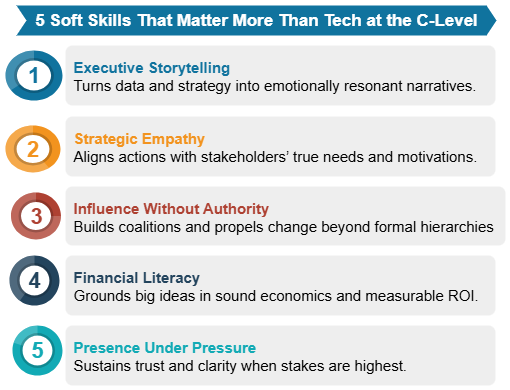
In an era where every boardroom buzzes with Gen AI, cloud migration, and digital-first thinking, it’s tempting to believe that technical depth is the ultimate success lever at the C-level.
But here’s the reality:
Technology is the tool. People drive transformation.
And people are inspired, mobilized, and retained not through code, but through soft skills—what I call the real power skills.
Whether you’re leading a cloud-native initiative or scaling an IoT platform, these five soft skills will elevate your impact more than any architecture diagram ever will.
1. Executive Storytelling Translating complexity into compelling narratives
At the executive level, clarity matters as much as correctness. Your ability to communicate strategy through stories—not just slides—is often what determines stakeholder alignment and momentum.
Example: For Explaining a complex IoT rollout to a non-technical board. Start with a relatable problem, share the journey, and paint a vivid “what’s next.”
2.Strategic Empathy Understanding others’ perspectives and motivations
Empathy isn’t softness—it’s strategy. C-level leaders who deeply understand what matters to their stakeholders (CFOs, customers, team leads) can shape decisions that land, stick, and scale.
Example: For aligning product features with end-user frustrations. Map out stakeholders’ top 3 motivators and objections before presenting change.
3.Influence Without Authority Driving buy-in beyond your formal role
In today’s matrixed, global organizations, influence is often earned, not assigned. You may not own the budget, but if you can inspire shared ownership, you’re leading at scale.
Example: For gaining support for a cross-functional digital upgrade. Collaborate on quick wins first—then ask for bigger support.
4.Financial Literacy Understanding key financial concepts and metrics
To inspire confidence among the C-suite and investors, leaders must translate innovation into business value. That means fluency in P&L, ROI, TCO—not just throughput or latency.
Example: For making the case for a new cloud platform investment. Show payback period, not just performance benchmarks.
5. Presence Under Pressure Maintaining composure in challenging situations
When things go wrong—and they will—teams don’t just need solutions. They need stability. Your composure, clarity, and tone set the emotional weather for your organization.
Example: For handling a major outage or security incident. Use anchor phrases (“Here’s what we know. Here’s what we’re doing.”) to ground the room.
Leading Beyond the Resume While technical fluency earns you the seat at the table, it’s these five soft skills that ensure you’ll lead, influence, and inspire from that seat.
Let’s stop calling them soft. These are the muscles that carry strategy, culture, and execution forward—especially at the top.
💬 Join the Conversation
What soft skills have been most valuable in your leadership journey? Share your thoughts below.